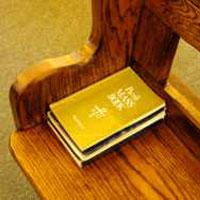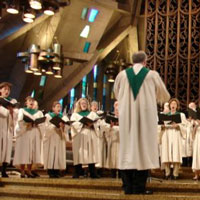- About Us
- Columns
- Letters
- Cartoons
- The Udder Limits
- Archives
- Ezy Reading Archive
- 2024 Cud Archives
- 2023 Cud Archives
- 2022 Cud Archives
- 2021 Cud Archives
- 2020 Cud Archives
- 2015-2019
- 2010-2014
- 2004-2009
 |
The Songs That Bind |
In the lead up to the Sydney Swans’ Australian Rules Football premiership victory recently, communal singing was revived in Sydney. AFL nuts, dressed in red and white V-necks and candy cane scarves, sang what sounded like hymns.
It makes sense fans did this because the various effects hymns have on people conform to the requirements of a good team anthem: they bind followers, alleviate fear, confirm faith and celebrate the relationship between singers and God, or in the case of team anthems, the equivalent local side.
 According to How Hymns Shape Our Lives, a book by American Reverend Rosalind Brown on hymnology, the best hymns engage us from the start while speaking the language of faith and teaching it through repetition. These songs develop a theme and require singers to respond.
According to How Hymns Shape Our Lives, a book by American Reverend Rosalind Brown on hymnology, the best hymns engage us from the start while speaking the language of faith and teaching it through repetition. These songs develop a theme and require singers to respond.
If we look at the Swans’ club song, it is a call to action from the first word. “Cheer, cheer the red and the white/ Honour the name by day and night/ Lift that noble banner high/ Shake down the thunder from the sky,” it says.
And as the capacity crowd chanted at the MCG, reading lyrics from a big screen and singing in unison, each supporter was unwittingly changed. Hymnologists would say that through the process of singing together in a congregational worship of sorts, Swans supporters united in a common hope – for premiership victory - and drew assurance from the solidarity afforded by other fans. They comfortably expressed their desires and invested themselves emotionally in the act of singing about them.
Singing is engaging because it requires both sides of the brain. The words tickle the logical left and the melodies stimulate the emotional right. The integration of both during worship, albeit for sporting heroes, heightens already intense emotions created by sharing an experience with a large group.
 The motivational impact of hymns is also huge, says Brown. For instance, slaves in the US used hymns to persevere in times of little human freedom. “As they sang, the future became now, and the motivation to persist was strengthened,” she says. Singing “their song” was a way to retain a sense of identity and believe in a better future.
The motivational impact of hymns is also huge, says Brown. For instance, slaves in the US used hymns to persevere in times of little human freedom. “As they sang, the future became now, and the motivation to persist was strengthened,” she says. Singing “their song” was a way to retain a sense of identity and believe in a better future.
Words set to a tune are more likely to be recalled than plain verse. Biblical teachings and imagery contained in hymns stick; they influence thought and behaviour more effectively than sermons, for instance. So what happens when songs, with the power to heighten emotion, motivate and shape behaviour, are used for purposes other than worship?
The history of hymns provides clues. The earliest hymns were composed to reinforce the orthodox faith against its detractors. Because hymns were readily absorbed by worshippers who became familiar with dense doctrinal language and biblical stories as a result of singing them, the church used song to educate and protect against heresy.
From the 18th century onwards, hymns targeted the behaviour of young children. “Little children must be quiet/ When to the holy church they go/ They must sit with serious faces/ Must not play or whisper low,” says one hymn. According to Brown, what children sing can be formative for the rest of their lives.
The popular children’s hymn, “All Things Bright and Beautiful” is an interesting case in point. Its tune was used for an RSPCA ad campaign in the 90s. As the melody played, cuddly animals, great and small, waddled across a white TV screen. Perhaps advertisers knew the hymn would evoke an idealistic view of the world we held as children singing that song. Or perhaps they knew we’d remember the lyrics and appreciate animals more as we watched them, reciting the words in our minds. Either way, the hymn is a good example of one that has stuck in the collective memory.
 Its success may lie in the vivid imagery contained in the lyrics: of birds of “glowing colours” and “ripe fruits in the garden”. But to remain in use, hymns must be revised and adapted, says Lawrence Bartlett in the foreword of Together in Song: Australian Hymn Book II, itself a 1999 revision of a 1977 publication, The Australian Hymn Book.
Its success may lie in the vivid imagery contained in the lyrics: of birds of “glowing colours” and “ripe fruits in the garden”. But to remain in use, hymns must be revised and adapted, says Lawrence Bartlett in the foreword of Together in Song: Australian Hymn Book II, itself a 1999 revision of a 1977 publication, The Australian Hymn Book.
A survey of hymn usage was conducted over a year in Australia in 1990. It found that some once-popular hymns were rarely sung because their archaic language, including words such as “thee” and “thou”, did not make sense to modern congregations who used prayer books and Bibles that had abandoned these words. Some groups threatened to stop using The Australian Hymn Book unless it was modernised, taking particular offence to what they saw as “gender exclusive language employed by authors”.
In the 1999 edition, ‘All Things Bright and Beautiful’ has three completely revamped verses. Instead of “Purple headed mountains/ The rivers running by,” we now have “The wildflowers in their beauty/ The mountain ranges tall/ The billabongs and rivers/ And friendly birds that call”. We no longer sing of British “meadows” and “greenwoods” but of “gum trees”, “coloured walls of gorges” and “bushland, field or desert/ On farms, or roaming free”.
Such changes helped Australian congregations relate to the liturgy, a particular concern of the Anglican Church since 1962 when a new constitution made the church autonomous and therefore free to break away from its British roots. An Australian Prayer Book, replete with a green and gold cover, replaced the imported 1662 Book of Common Prayer and the ‘Church of England in Australia’ changed its name to the ‘Anglican Church of Australia’ in 1981. The first of edition of the Australian Hymn Book was released in the context of a nationalisation of Anglicanism in Australia.
This tweaking of hymns to make them more relevant to targeted audience has contributed to an enormous range of church music now available to worshippers. What hymn diversity does, according to Brown, is make the formational effects of hymns more local “as what one church sings has become very different from its neighbour….This immense range suggests that we lack a common corpus of hymnody,” she says.
 For instance, the Assemblies of God church in Australia, Hillsong, has its own record label, Hillsong Music, which sells high-energy Christian pop to a very specific youth market. One Hillsong album, For All You’ve Done, reached number one on the ARIA charts. While hymnology suggests this music will bind the 4 million people who bought the album and sing the songs together at services, these believers will have a vastly different interpretation of religious language and God to others raised on a traditional ‘How Great Thou Art’-type hymn diet.
For instance, the Assemblies of God church in Australia, Hillsong, has its own record label, Hillsong Music, which sells high-energy Christian pop to a very specific youth market. One Hillsong album, For All You’ve Done, reached number one on the ARIA charts. While hymnology suggests this music will bind the 4 million people who bought the album and sing the songs together at services, these believers will have a vastly different interpretation of religious language and God to others raised on a traditional ‘How Great Thou Art’-type hymn diet.
The music of the former, according to Brown, focus on the singer’s relationship with God, while traditional hymns aim to explain Christ’s teachings before moving into the human responses these draw. Charismatic church songs also tend to represent the relationship with God as personal using the singular “I”, “me” and “my” instead of the collective “we”, “us” and “our” of old. “As for me, God came and found me…” the Hillsong track by Darlene Zschech ‘God is in the House’ begins. Such self-focus detracts from the unifying capacity of hymns.
So what then of communal religious worship in the future? If, say, an Anglican in Sydney’s Hills district is singing vastly different hymns to one in the Shire, hymnology tells us they are being shaped in very different ways: the way they speak of God, the biblical stories they learn and the way they view their relationship with God will not bind them as believers in the one denomination. Perhaps donning the red and white and singing a few impassioned verses at the footy will provide the sense of community once acquired by singing hymns to God at church.
